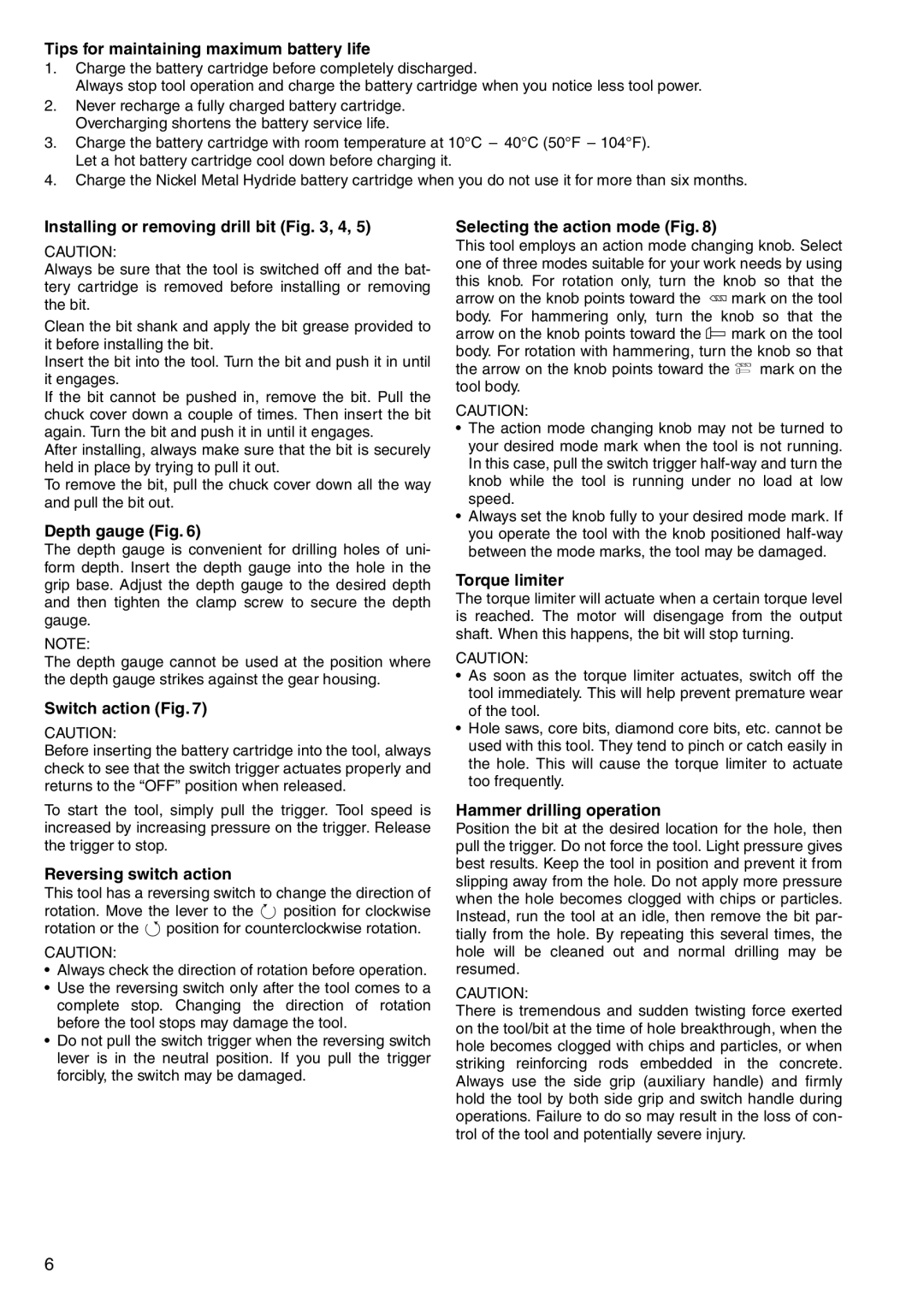Tips for maintaining maximum battery life
1.Charge the battery cartridge before completely discharged.
Always stop tool operation and charge the battery cartridge when you notice less tool power.
2.Never recharge a fully charged battery cartridge. Overcharging shortens the battery service life.
3.Charge the battery cartridge with room temperature at 10°C – 40°C (50°F – 104°F). Let a hot battery cartridge cool down before charging it.
4.Charge the Nickel Metal Hydride battery cartridge when you do not use it for more than six months.
Installing or removing drill bit (Fig. 3, 4, 5)
CAUTION:
Always be sure that the tool is switched off and the bat- tery cartridge is removed before installing or removing the bit.
Clean the bit shank and apply the bit grease provided to it before installing the bit.
Insert the bit into the tool. Turn the bit and push it in until it engages.
If the bit cannot be pushed in, remove the bit. Pull the chuck cover down a couple of times. Then insert the bit again. Turn the bit and push it in until it engages.
After installing, always make sure that the bit is securely held in place by trying to pull it out.
To remove the bit, pull the chuck cover down all the way and pull the bit out.
Depth gauge (Fig. 6)
The depth gauge is convenient for drilling holes of uni- form depth. Insert the depth gauge into the hole in the grip base. Adjust the depth gauge to the desired depth and then tighten the clamp screw to secure the depth gauge.
NOTE:
The depth gauge cannot be used at the position where the depth gauge strikes against the gear housing.
Switch action (Fig. 7)
CAUTION:
Before inserting the battery cartridge into the tool, always check to see that the switch trigger actuates properly and returns to the “OFF” position when released.
To start the tool, simply pull the trigger. Tool speed is increased by increasing pressure on the trigger. Release the trigger to stop.
Reversing switch action
This tool has a reversing switch to change the direction of rotation. Move the lever to the n position for clockwise rotation or the o position for counterclockwise rotation.
CAUTION:
•Always check the direction of rotation before operation.
•Use the reversing switch only after the tool comes to a complete stop. Changing the direction of rotation before the tool stops may damage the tool.
•Do not pull the switch trigger when the reversing switch lever is in the neutral position. If you pull the trigger forcibly, the switch may be damaged.
Selecting the action mode (Fig. 8)
This tool employs an action mode changing knob. Select one of three modes suitable for your work needs by using this knob. For rotation only, turn the knob so that the arrow on the knob points toward the M mark on the tool body. For hammering only, turn the knob so that the arrow on the knob points toward the x mark on the tool body. For rotation with hammering, turn the knob so that the arrow on the knob points toward the N mark on the tool body.
CAUTION:
•The action mode changing knob may not be turned to your desired mode mark when the tool is not running. In this case, pull the switch trigger
•Always set the knob fully to your desired mode mark. If you operate the tool with the knob positioned
Torque limiter
The torque limiter will actuate when a certain torque level is reached. The motor will disengage from the output shaft. When this happens, the bit will stop turning.
CAUTION:
•As soon as the torque limiter actuates, switch off the tool immediately. This will help prevent premature wear of the tool.
•Hole saws, core bits, diamond core bits, etc. cannot be used with this tool. They tend to pinch or catch easily in the hole. This will cause the torque limiter to actuate too frequently.
Hammer drilling operation
Position the bit at the desired location for the hole, then pull the trigger. Do not force the tool. Light pressure gives best results. Keep the tool in position and prevent it from slipping away from the hole. Do not apply more pressure when the hole becomes clogged with chips or particles. Instead, run the tool at an idle, then remove the bit par- tially from the hole. By repeating this several times, the hole will be cleaned out and normal drilling may be resumed.
CAUTION:
There is tremendous and sudden twisting force exerted on the tool/bit at the time of hole breakthrough, when the hole becomes clogged with chips and particles, or when striking reinforcing rods embedded in the concrete. Always use the side grip (auxiliary handle) and firmly hold the tool by both side grip and switch handle during operations. Failure to do so may result in the loss of con- trol of the tool and potentially severe injury.
6
